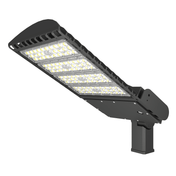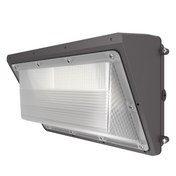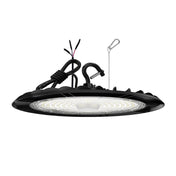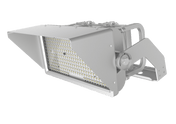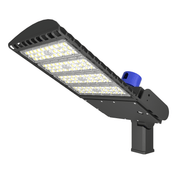In modern industrial and commercial spaces, efficient and reliable lighting systems are key to improving productivity, ensuring safety, and reducing operating costs. Traditional lighting technologies, such as metal halide lamps, are gradually being phased out due to issues such as high energy consumption, frequent maintenance, and inconsistent light quality. LED UFO high bay lights, with their superior energy efficiency, long lifespan, and innovative design, are becoming the lighting solution of choice for large warehouses, factories, stadiums, logistics centers, and other locations. This article will delve into their technical principles, core advantages, application scenarios, and key purchasing considerations to help you understand the core trends in industrial lighting upgrades.
What is an LED UFO High Bay Light?
The LED UFO high bay light is an LED lighting fixture designed for tall spaces (ceiling heights ≥ 6 meters). It is named for its distinctive UFO-like shape. Its core features include:
Directional and efficient light emission: Utilizing multiple high-power LED chips (such as the 3030/5050 series) as light sources, these are precisely distributed through lenses or reflectors (typically with a beam angle of 60°–120°), focusing light onto the floor or work area, reducing ineffective scattering and energy consumption.
Compact heat dissipation design: The die-cast aluminum housing and finned heat sink (aerodynamic structure) quickly dissipate heat, ensuring the LED junction temperature remains within a safe range (≤65°C), extending the lifespan to over 50,000–75,000 hours.
Energy-saving and environmentally friendly: With a luminous efficacy of 130–170 lm/W (compared to 60–90 lm/W for traditional metal halide lamps), these lamps can replace traditional lamps with 3–5 times the wattage, achieving energy savings exceeding 60%–70%. For example, a 150W LED UFO lamp can replace a 450W metal halide lamp, significantly reducing electricity costs.
Durability and Protection: With IP65/IP66 protection (dust and water resistant) and IK07–IK08 impact resistance, they withstand harsh industrial environments such as humidity, dust, and vibration.
Intelligent Control Compatibility: Supports 0–10V/DALI dimming, microwave/infrared sensing, and daylight integration, enabling on-demand lighting, further energy savings, and enhanced flexibility.
Core Advantages: Why Are LED UFO Lamps the Preferred Choice for Industrial Lighting?
1. Revolutionary Performance-to-Efficiency: Lower Energy Consumption, Higher Brightness
Energy Efficiency Revolution: Traditional metal halide lamps convert approximately 80% of electrical energy into heat during the light-emitting process, while LEDs achieve significantly higher electro-optical conversion efficiency. Field-tested data shows that LED UFO lamps use over 60% less energy than metal halide lamps, resulting in significant long-term savings in electricity costs (assuming 100 200W lamps operating for 3,000 hours per year can save tens of thousands of kWh).
Instant Startup and Stable Light Quality: LEDs require no warm-up and reach full brightness instantly upon power-up, with zero flicker and glare (through optimized optical design using Unified Glare Reduction (UGR) technology), reducing visual fatigue and improving work efficiency and safety.
Lifespan Advantage: With an average lifespan of over 50,000 hours (approximately 5–7 years), this significantly reduces replacement frequency and maintenance costs, making it particularly suitable for high-altitude installations (where traditional lamps require frequent replacement at height, posing a high safety risk).
2. Optical and Design Innovation: Precise Light Distribution and a User-Friendly Experience
Optimized Light Distribution: Professional optical design (such as lens arrays or reflectors) achieves uniform light coverage, eliminating dark areas and glare. For example, a narrow beam angle (60°–90°) is suitable for warehouses with dense shelving, while a wide beam angle (120°) is ideal for open factories or gymnasiums.
UGR Glare Control: The Unified Glare Reduction (UGR) is a key indicator of lighting comfort. High-quality LED UFO lamps utilize a deep cavity anti-glare structure, nano-diffuse reflective coating, or grille design to strictly control the UGR to ≤19 (required for delicate work areas) or ≤22 (for general areas). This complies with GB/T 50034 and ISO standards, protecting workers' eyesight and enhancing visual comfort.
Color Temperature and Color Rendering Options: High color rendering index (CRI ≥80) options are available, including 4000K (natural light) and 5000K (cool white light), accurately reproducing object colors and making them suitable for applications requiring high lighting quality, such as quality inspection and precision machining.
3. Environmental Adaptability and Sustainability
Extreme Environment Tolerance: Supporting a wide voltage input (AC 90–305V), wide operating temperature (-40°C–+50°C), and a moisture- and corrosion-resistant design, these lamps meet the requirements of specialized environments such as cold storage, chemical plants, and coastal factories.
Environmentally friendly: Free of hazardous substances such as mercury and lead, RoHS compliant, and containing a high proportion of recyclable materials, it helps businesses achieve ESG goals and LEED/BREEAM certification requirements.
Smart Connectivity: Integrated IoT interfaces (such as the DALI protocol) enable integration into smart lighting systems, enabling remote monitoring, group control, energy consumption analysis, and sensor interaction (light turns on when someone approaches, and turns off after a delay when someone leaves), further optimizing management and energy conservation.
4. Ease of Installation and Maintenance
Flexible Installation: Supports hook, chain, pipe thread (NPT), or rail mounting to accommodate various building structures. Select models feature an angle adjustment bracket (±90°) for precise adjustment of illumination direction.
Modular Design: The driver and light source modules can be separated and replaced, eliminating the need to disassemble the entire lamp for maintenance, reducing the difficulty and cost of high-altitude work.
Application Scenario: Where is the LED UFO high bay light suitable?
The high brightness, wide coverage, and environmental adaptability of LED UFO lamps make them ideal for the following scenarios:
Industrial manufacturing: Large workshops, machining areas, assembly lines, and warehouse logistics centers (with shelves over 10 meters high), ensuring safe and efficient operations.
Commercial and public spaces: Large supermarkets, shopping malls, exhibition halls, gymnasiums (basketball/badminton courts, etc.), and transportation hubs (waiting rooms, airport cargo warehouses), providing bright and comfortable ambient lighting.
Special environments: Cold storage (low-temperature resistant design), gas stations (explosion-proof models available), port warehouses (dustproof, waterproof, and corrosion-resistant), and gyms (high humidity environments).
Energy-saving renovation projects: Upgrading old factories or warehouses from metal halide/high-pressure sodium lamps to LEDs provides a rapid return on investment (typically within 2–3 years).
Case Study: London King's Cross Station replaced old fixtures with LEDVANCE high-bay luminaires, achieving 60% energy savings and improving maintenance ease. A large domestic factory adopted Sansi LED UFO lighting solutions, significantly improving illumination uniformity in the workshop, optimizing the UGR value to a safe range, and reducing worker visual fatigue.
Buying Guide: How to Choose a High-Quality LED UFO High-Bay Light?
Faced with the dazzling array of products on the market, the following key evaluation criteria will help you make an informed decision:
1. Core Specifications Matching Requirements
Wattage and Luminous Flux: Choose the appropriate wattage based on the height and area of the space (typically 100W–400W). For example, a 10-meter-high, 1,000-square-meter warehouse is recommended to use 150–200W luminaires to ensure floor illumination meets standards (general industrial areas require 150–300 lux).
Beam Angle and Light Distribution: Narrow angles (60°–90°) are suitable for vertical lighting of shelves or high workstations, while wide angles (120°) provide uniform coverage over large areas. Asymmetrical light distribution can be used to provide targeted emphasis in key areas (such as workbenches and aisles).
Color Temperature and Color Rendering Index: For precision operations, choose 4000K–5000K with a CRI ≥85. For display or public areas, choose warm white light (3000K–4000K) with a higher CRI (CRI ≥90).
2. Quality and Reliability Verification
Certifications: Prefer products with authoritative certifications such as UL/DLC (North America), ETL/CE (Europe), and CCC (China) to ensure safety and performance compliance. DLC Premium certification can also support applications for local energy-saving subsidies (e.g., electricity bill discounts or cash rebates in some regions).
Heat Dissipation and Structural Design: The die-cast aluminum fin heatsink features ample surface area and optimal fin spacing to promote air convection. The housing is ≥1.5mm thick to ensure strength and heat dissipation efficiency. The lens is made of UV-resistant polycarbonate (PC) material, which is non-yellowing and impact-resistant (IK08 rating).
Driver Quality: A built-in constant-current driver from renowned brands such as Mean Well supports a wide input voltage, surge protection (lightning resistance rating ≥4kV), and over-temperature/over-current protection to ensure long-term stable operation.
3. Intelligent and Control Functions
Dimming Compatibility: Supports 0–10V analog dimming or DALI digital dimming, facilitating integration with intelligent systems for brightness adjustment and scene presets (such as low-brightness operation for nighttime duty mode).
Sensor Integration: Optional microwave/infrared sensor modules enable light on upon arrival and delayed off upon departure (adjustable from 8 seconds to 12 minutes), maximizing energy savings (especially suitable for low-frequency use areas).
IoT Expansion: Reserved interfaces support connection to smart platforms (such as Interact or customized systems) for remote monitoring of energy consumption, fault warnings, and lamp health.
4. Cost-Effectiveness and Service Guarantee
Lifecycle Cost: Focus not only on the purchase price but also on calculating long-term costs by integrating energy consumption, maintenance, and replacement frequency. While high-quality LED lamps may require a slightly higher initial investment, their energy savings and longevity significantly reduce the total cost of ownership (TCO).
Warranty and After-Sales Service: Select suppliers that offer a five-year or longer warranty on core components (LED modules and drivers) to ensure long-term support. Clearly define fault response mechanisms and technical support channels (such as online customer service and installation guides).
Market Trends and Future Outlook
Continuous Breakthroughs in Energy Efficiency: With advancements in LED chip technology (such as the application of Mini LED or Micro LED), luminous efficacy is expected to exceed 200 lm/W, further reducing baseline energy consumption.
Intelligent and Connected: Lighting systems are evolving towards "adaptive environmental" capabilities, leveraging AI, sensor networks, and big data analytics to enable dynamic light control and even deep integration with building management systems (BMS).
Sustainable Design Advancement: Material innovation (such as recyclable bio-based plastics and low-carbon aluminum processes) and the improvement of closed-loop recycling systems are driving the industry's green transformation.
Emerging Applications: Smart agriculture (vertical lighting in plant factories), underground spaces (mines/tunnels), and high-end commercial complexes are increasing their demands for lighting quality and user experience, creating more applications for LED UFO lamps.
VI. Action Recommendation: Upgrade Your Lighting System
If you are considering upgrading the lighting in your industrial or commercial space, LED UFO high-bay lamps are undoubtedly a cost-effective, high-performance, and forward-looking option. The following implementation steps are provided as a reference:
Assess the Current Situation: Measure space dimensions, existing illumination, energy consumption levels, and pain points (such as glare, dark areas, and frequent malfunctions).
Design a Solution: Use professional lighting design software (such as DIALux EVO) to simulate lamp layout, calculate the required number and power, and ensure that indicators such as uniformity and UGR are met.
Supplier Selection: Prioritize manufacturers that offer UL/DLC certification, comprehensive after-sales service, and customized solutions (such as adjustable power/color temperature models, like your Shopify store products!).
Installation and Verification: Installation should be completed by a licensed electrician (complying with the NEC or local electrical codes). After powering on, verify brightness, uniformity, and intelligent features for proper operation.
Long-Term Optimization: Integrate with an energy management system to continuously track energy savings and adjust control strategies based on user feedback.
Conclusion
LED UFO high-bay luminaires are revolutionizing industrial and commercial lighting with their high energy efficiency, precise light control, environmental tolerance, and intelligent potential. Whether for logistics companies seeking cost savings or advanced factories prioritizing employee experience, these luminaires provide a reliable and future-proof solution. As a professional supplier, you can convey this value through your Shopify website—not only showcasing product specifications but also sharing in-depth technical analysis, success stories, and practical guides to help customers understand the value of their investment and build trust.




